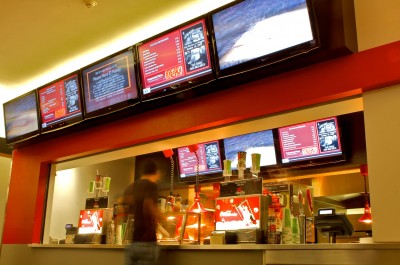By Jeff Collard
Digital signage has become an increasingly important visual aspect of many of today’s business environments, where rapid change and adaptability are crucial to success. As a medium, digital signage represents an effective way to manage complex or time-sensitive information.
One of the key factors is automation. By empowering organizations with digital signage technology, the management and updating of content—which could otherwise become onerous tasks—can be handled instantaneously, saving time and money.
The presence of digital signage has grown substantially in the food-service industry, for example, where its value is seen in the form of digital menu boards. More and more companies in this sector are recognizing the cost-cutting and revenue-increasing benefits of moving away from traditional static displays, including backlit signs and posters. From quick-service restaurants (QSRs) to stadiums, amusement parks to universities’ student centres, a wide variety of organizations are turning to digital signage to help improve efficiency, branding and sales.
Simplifying customization
One of the benefits of deploying digital menu boards is the capability to segment on-screen content, allowing space not only for lists of menu items and prices, but also for in-house promotions and externally sourced advertising.

One of the advantages of digital menu boards is the ability to segment templates for on-screen layout, with space not only for menu items and prices, but also for promotions and externally sourced ads.
Further, when configuring content playlists within their digital signage software, companies can create rules to dictate when and where specific types of content should or should not be displayed, based on metadata (i.e. information about the content).
A sports arena, for example, may be required to stop serving alcoholic beverages after a certain inning or period in a game. With digital signage, it becomes easier to showcase beer early in the game and then stop promoting it after a set point in time. The ad is simply removed from the screen and replaced with other content.
Similarly, if a certain product is selling well and crosses a particular threshold, the software may be set up to promote that item more prominently as part of the screen display, taking advantage of the current trend. Digital signage systems can handle these functions without needing users to create multiple, complex playlists.
While external advertising does not appear on all digital menu boards, it has become a key revenue generator for food-service providers in arenas and stadiums, thanks to rule creation and metadata. In these scenarios, ad placement is tied to ongoing events. When a well-known athlete plays a great game or reaches a career milestone, for example, his/her jersey can be heavily promoted. Since this type of advertising only operates within a short, designated window, making effective use of limited time is critically important to its success.
In addition to food and beverage sales, merchandising and sponsorship revenues are a key part of the arena and stadium business model. For a 20,000-person sports facility, ad space typically generates more than $500,000 each year, which can more than justify the upfront cost of implementing a digital signage network.






